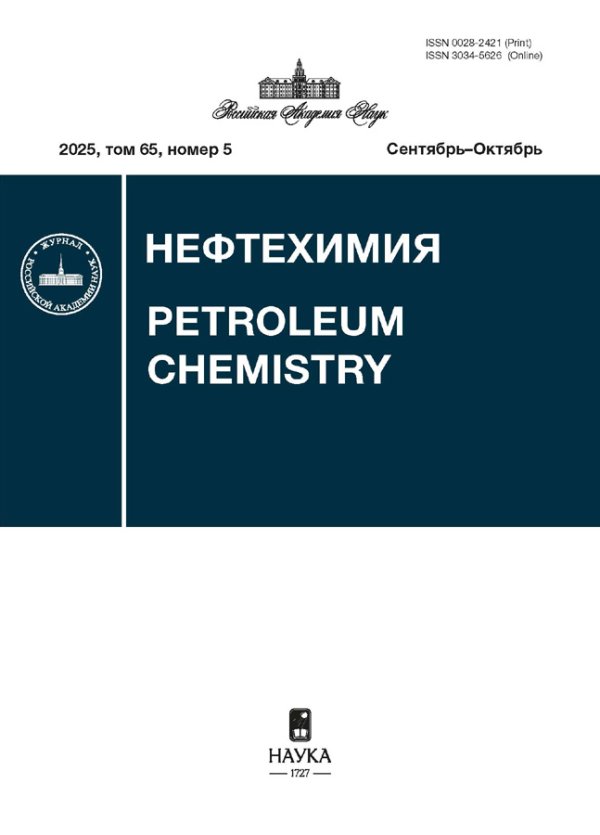Совместная каталитическая переработка полиэтилентерефталата и поликарбоната в ароматические углеводороды на фосфиде никеля
- Авторы: Голубева М.А.1, Мухтарова М.1
-
Учреждения:
- Институт нефтехимического синтеза им. А. В. Топчиева РАН
- Выпуск: Том 65, № 2 (2025)
- Страницы: 128-133
- Раздел: Статьи
- URL: https://gynecology.orscience.ru/0028-2421/article/view/686748
- DOI: https://doi.org/10.31857/S0028242125020057
- EDN: https://elibrary.ru/KLXKTC
- ID: 686748
Цитировать
Полный текст
Аннотация
Проведены каталитические гидропревращения отходов кислородсодержащих пластиков: полиэтилентерефталата (ПЭТФ) и поликарбоната (ПК). Никельфосфидный катализатор реакции гидропревращения, содержащий кристаллические фазы Ni2P и Ni(PO3)2, получен in situ в процессе совместной переработки данных пластиков. Исследование катализатора проведено методами рентгенофазового анализа (РФА) и рентгеновской фотоэлектронной спектроскопии (РФЭС). С использованием образующегося катализатора в результате количественной переработки пластиков получены C6–C10-ароматические углеводороды с селективностью до 89% при 400°C, начальном давлении водорода 9 МПа и проведении реакции в течение 6 ч.
Полный текст
Об авторах
Мария Андреевна Голубева
Институт нефтехимического синтеза им. А. В. Топчиева РАН
Автор, ответственный за переписку.
Email: vinnikova@ips.ac.ru
ORCID iD: 0000-0002-3741-7833
SPIN-код: 2282-9612
к. х. н.
Россия, Москва, 119991Мариям Мухтарова
Институт нефтехимического синтеза им. А. В. Топчиева РАН
Email: vinnikova@ips.ac.ru
ORCID iD: 0000-0003-1215-6136
SPIN-код: 2809-4340
Россия, Москва, 119991
Список литературы
- Kibria M.G., Masuk N.I., Safayet R., Nguyen H.Q., Mourshed M. Plastic waste: Challenges and opportunities to mitigate pollution and effective management // Int. J. Environ. Res. 2023. V. 17. ID20. https://doi.org/10.1007/s41742-023-00507-z
- Kijo-Kleczkowska A., Gnatowski A. Recycling of plastic waste, with particular emphasis on thermal methods — review // Energies. 2022. V. 15, № 6. ID2114. https://doi.org/10.3390/en15062114
- Chen S., Hu Y.H. Advancements and future directions in waste plastics recycling: From mechanical methods to innovative chemical processes // Chem. Eng. J. 2024. V. 493. ID152727. https://doi.org/10.1016/j.cej.2024.152727
- Ragaert K., Delva L., Van Geem K. Mechanical and chemical recycling of solid plastic waste // Waste Manag. 2017. V. 69. P. 24–58. https://doi.org/10.1016/j.wasman.2017.07.044
- Schyns Z.O.G., Shaver M.P. Mechanical recycling of packaging plastics: A review // Macromol. Rapid Commun. 2021. V. 42, № 3. ID2000415. https://doi.org/10.1002/marc.202000415
- Tan T., Wang W., Zhang K., Zhan Z., Deng W., Zhang Q., Wang Y. Upcycling plastic wastes into value-added products by heterogeneous catalysis // ChemSusChem. 2022. V. 15, № 14. ID e202200522. https://doi.org/10.1002/cssc.202200522
- Jing Y., Wang Y., Furukawa S., Xia J., Sun C., Hülsey M.J., Wang H., Guo Y., Liu X., Yan N. Towards the circular economy: Converting aromatic plastic waste back to arenes over a Ru/ catalyst // Angew. Chem. 2021. V. 133, № 10. P. 5587‒5595. https://doi.org/10.1002/anie.202011063
- Golubeva M., Mukhtarova M., Sadovnikov A., Maximov A. PET waste recycling into BTX fraction using in situ obtained nickel phosphide // Polymers. 2023. V. 15, № 10. ID2248. https://doi.org/10.3390/polym15102248
- Mukhtarova M., Golubeva M.A., Maximov A.L. In situ catalyst for the selective processing of terephthalic acid into BTX fraction // Appl. Catal. A: Gen. 2024. V. 678. ID119734. https://doi.org/10.1016/j.apcata.2024.119734
- Shi G., Shen J. New synthesis method for nickel phosphide nanoparticles: solid phase reaction of nickel cations with hypophosphites // J. Mater. Chem. 2009. V. 19. P. 2295–2297. https://doi.org/10.1039/B903088N
- Guan Q., Li W., Zhang M., Tao K. Alternative synthesis of bulk and supported nickel phosphide from the thermal decomposition of hypophosphites // J. Catal. 2009. V. 263, № 1. P. 1–3. https://doi.org/10.1016/j.jcat.2009.02.008
- Lee Y.K., Oyama S.T. Bifunctional nature of a -supported catalyst for hydrotreating: EXAFS and FTIR studies // J. Catal. 2006. V. 239, № 2. P. 376–389. https://doi.org/10.1016/j.jcat.2005.12.029
- Li K., Wang R., Chen J. Hydrodeoxygenation of anisole over silica-supported , MoP, and NiMoP сatalysts // Energy Fuels. 2011. V. 25. № 3. P. 854–863. https://doi.org/10.1021/ef101258j
- Kim J.G. Chemical recycling of poly(bisphenol A carbonate) // Polym. Chem. 2020. V. 11. P. 4830–4849. https://doi.org/10.1039/C9PY01927H
Дополнительные файлы










